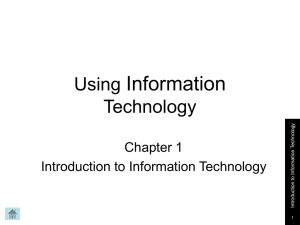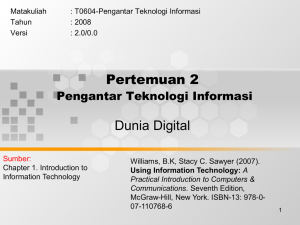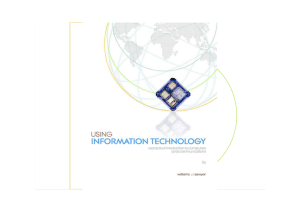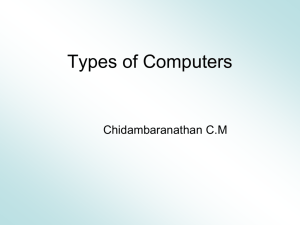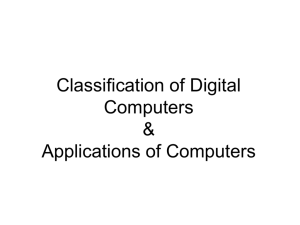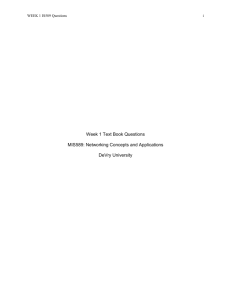Introduction to Information Technology Mind Tools for Your Future
advertisement
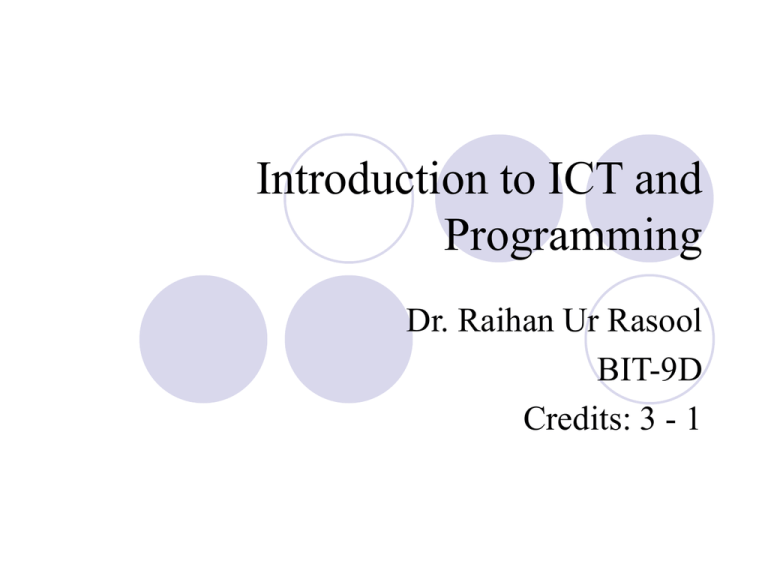
Introduction to ICT and Programming Dr. Raihan Ur Rasool BIT-9D Credits: 3 - 1 Contacts Office: Academic Block -II Phone 051-9280439 Ext 129 Office Hours: Monday 1000 – 1200 hrs email: dr.raihan@niit.edu.pk Exceptional meeting: Give me an email and get time. 2 Course Outline Part A Introduction to IT Computing & Communication Understanding Computer Peripheral Devices Connectivity, Interactivity & Multimedia Internet Access Devices and connecting medias World Wide Web Browsers & Search Engines Web Page Basic Design Application Software Microsoft Office Operating Systems Hardware Technology System Unit Storage Devices Data Entry Devices Output Devices Telecommunications Basics of Digital & Analogue Signal Digital Communication Networks & Protocols Databases Data Mining E-Commerce Security Issues Artificial Intelligence System Development 3 Course Outline Part B (Major portion – expected start 10th week) Introduction to Programming Programming Languages Problems solving Techniques Basics of C++ Control structures Functions Arrays & Strings 4 Books Text Books Using Information Technology by Brian K. Williams and Stacy C. Sawyer (6th Edition) Object Oriented Programming in C ++ by Robert Lafore (4th edition) 5 Books Reference Books (very important part) Peter Norton’s Introduction to Computers 5th Edition Computers by Larry Long, Nancy Long 6th Edition Computer Fundamentals by P.K. Sinha Concepts by Parson Oja Introduction to computes and information systems by Robert A., Donald P., Norma A., donna M. (2nd Edition) C++ How To Program by Dietel & Dietel (3rd Edition) C++ Web material www.howstuffworks.com www.whatis.com 6 Evaluation Quizzes : One Hour Tests : Lab : Assignments : Project : Final Test : 10 % 30 % 5% 5% 5% 45% 7 Policies Bring your own calculator, pen paper etc.. You will not be allowed to borrow anything from anyone during any test Must write your name and reference number (Merit No or Regn No) in a test No late work will be accepted (unless arrangements have been made in advance) Ask questions; participate actively in class You are allowed to talk to instructor only 8 Policies You are responsible for what is covered in class – even if you don’t show up Deficiency in attendance may lead to termination or relegation You are encouraged to help each other with your homework assignments – but you must turn in your own work If you are found to be cheating, you will fail at least the assignment / test and perhaps the entire class 9 Policies If you have any learning disabilities or special needs, please let me know in advance through email or personal meeting Check your email regularly for messages Quizzes are unannounced 10 Computer Usage Operating Systems Windows 98/2000/XP Red Hat Linux Microsoft Office MS Word 2000 MS Excel 2000 MS Power Point 2000 MS FrontPage 2000 Programming IDE VC++ 6.0 Developer C++ Turbo C++ 3.0 Web Browsers MS Internet Explorer 6.0 Netscape Communicator Mozilla Email Editors Outlook Express Utilities Winzip 8.0 Winrar DOS Utilities etc. System Troubleshooting 11 Using Information Technology Chapter 1 Introduction to Information Technology Computer Technology Computer computes Programmable, multiuse machine that accepts data and figures and processes it into usable information. Data & Instructions Processing/ Computation Information/Results Storage 13 Few Basics…. 2/6 Computer Hardware CPU Memory Software I/O Etc. Application Software System Software 14 Communications the activity of communicating; the activity of conveying information An event that causes an action Event is a signal A signal is an intended message of communication Action is a process in relation to the event 15 Online Availability for communication You cannot be online if you have a computer, modem but not a phone line 16 Introduction to Information Technology Mind Tools for Your Future 1.1 Infotech Becomes Commonplace: Cellphones, EMail, the Internet, & the E-World 1.2 The “All-Purpose Machine”: The Varieties of Computers 1.3 Understanding Your Computer: What If You Custom-Ordered Your Own PC? 1.4 Where is Information Technology Headed? 17 Section 1.1 - InfoTech Becomes Commonplace: Cell phones, E-Mail, the Internet, & the E-World InfoTech: InfoTech is the fusion of computer technology and communication technology. InfoTech is the merging of computers with high-speed communications links carrying data, sound, and video. 18 Communication Technology Consists of electromagnetic devices and systems for communicating over long distances. Electromagnetic: Referring to the combined electric and magnetic fields caused by electron motion through conductors 19 Online Availability for communication Using a computer or other information device, connected through a voice or data network, to access information and services from another computer or Can you be online with a mobile phone? 20 E-mail (Electronic mail) Messages transmitted over a computer network A great overview on how E-mail works can be found at the following web site: http://www.howstuffworks.com/email.htm Do read it might be a quiz coming your way! 21 1.2 The “All-Purpose Machine”: The Varieties of Computers All Computers, Great & Small: The Categories of Machines 1. Supercomputers 2. Mainframes 3. Workstations 4. Microcomputers 5. Microcontrollers 22 Supercomputers High-capacity machines with hundreds of thousands of processors that can perform over 1 trillion calculations per second. E.g IBM ASCI White, Cray Used where High Performance computing is required Usually used for weather forecasting, Missile simulations, Nuclear Fusion simulations IBM ASCI White IBM ASCI White 23 Mainframes Water- or air-cooled computers that vary in size from small, to medium, to large, depending on their use. E.g IBM AS/400 Normally Dumb Terminals are connected to these main frames. Processing is done by Main Frames Dumb terminals only have keyboard, monitors VP2400 mainframe 24 Workstations Expensive, powerful computers usually used for complex scientific, mathematical, and engineering calculations and for computer-aided design and computer-aided manufacturing. e.g. Sun blade 2500 Sun Microsystems workstation 25 Microcomputers A Desk Top Personal Computer Your home computers… Celeron Now Desktop and Workstations are combining. i.e Your PC is also becoming powerful enough 26 Microcomputers A Tower Case Personal Computer Sony tower PC 27 Microcomputers A Lap Top Personal Computer Lightweight portable computers with built-in monitor, keyboard, hard-disk drive, battery and AC adapter. 28 Microcomputers A Personal Digital Assistant Getting Very popular Personal organization tools-schedule planners, address books, to-do lists, send e-mail and faxes. New generation that incorporates mobile phone and microcomputer. HP 5555 29 Microcontrollers Embedded computers are the tiny, specialized microprocessors installed in "smart" appliances and automobiles. Question: Difference b/w microcontrollers and microprocessors 30 1.3 Understanding Your Computer How Computers Work - Concept #1 The purpose of a computer is to process data into information Data The raw facts and figures that are processed into information . Information Data that has been summarized or otherwise manipulated for use in decision making 31 How Computers Work - Concept #2 Computers consist of hardware and software. Hardware All the machinery and equipment in a computer system Software All the instructions that tell the computer how to perform a task 32 How Computers Work - Concept #2 Computers also consist of firmware and liveware. Firmware Liveware l Instructions or programs that reside inside Integrated Circuits (ICs) All the living things aiding computer to work. Data entry operators, programmers etc 33 How Computers Work - Concept #3 All computers follow the same five basic operations. 1. Input 2. Processing 3. Storage Keyboard 4. Output 5. Communications Mouse 34 How Computers Work - Concept #3 All computers follow the same four basic operations 1. Input 2. Processing 3. Storage 4. Output 5. Communications Case or system cabinet 35 How Computers Work - Concept #3 All computers follow the same four basic operations 1. Input 2. Processing 3. Storage 4. Output Processor chip 5. Communications 36 How Computers Work - Concept #3 All computers follow the same four basic operations 1. Input 2. Processing 3. Storage 4. Output Memory chips 5. Communication s 37 How Computers Work - Concept #3 All computers follow the same four basic operations 1. Input 2. Processing 3. Storage 4. Output 5. Communications Motherboard 38 How Computers Work - Concept #3 All computers follow the same four basic operations 1. Input 2. Processing 3. Storage 4. Output 5. Communications Primary storage (memory) Computer circuitry that temporarily holds data waiting to be processed (normally called Buffers) Secondary storage (HDD) 39 How Computers Work - Concept #3 All computers follow the same four basic operations 1. Input 2. Processing 3. Storage 4. Output 5. Communications BIT – 1 line that can have either +Voltage or 0 Voltage. (+ can vary from device to device like 5 volts for parallel port) Byte – 8 bits of data Kilobyte – 210 bytes of data = 1024 bytes Megabyte – 220 bytes of data = 1048576 Gigabyte – 230 bytes of data = 1073741824 40 How Computers Work - Concept #3 All computers follow the same four basic operations 1. Input 2. Processing 3. Storage Floppy disk 4. Output 5. Communications Zip disk 41 How Computers Work - Concept #3 All computers follow the same four basic operations 1. Input 2. Processing 3. Storage 4. Output 5. Communications Hard-disk drive 42 How Computers Work - Concept #3 All computers follow the same four basic operations 1. Input 2. Processing 3. Storage 4. Output 5. Communications 43 How Computers Work - Concept #3 All computers follow the same four basic operations 1. Input 2. Processing 3. Storage 4. Output Sound card 5. Communications Sound Card 44 How Computers Work - Concept #3 All computers follow the same four basic operations 1. Input 2. Processing 3. Storage 4. Output 5. Communications Speakers 45 How Computers Work - Concept #3 All computers follow the same four basic operations 1. Input 2. Processing 3. Storage 4. Output 5. Communications Video card 46 How Computers Work - Concept #3 All computers follow the same four basic operations 1. Input 2. Processing 3. Storage 4. Output 5. Communications Monitor 47 How Computers Work - Concept #3 All computers follow the same four basic operations 1. Input 2. Processing 3. Storage 4. Output 5. Communications Printer 48 How Computers Work - Concept #3 All computers follow the same four basic operations 1. Input 2. Processing 3. Storage 4. Output 5. Communications Modem 49 Put all the hardware together and… 50 You still need the software! System software (Operating System) Helps the computer perform essential operating tasks and enables the application software to run and… 51 You still need the software! Application software Enables you to perform specific tasks--solve problems, perform work, or entertain yourself 52 1.4 Where Is Information Technology Headed? Three Directions of Computer Development Miniaturization Speed Affordability Then (1946) Now 53 Three Directions of Communications Development Connectivity Interactivity Multimedia Auto PC 54 When Computers & Communications Combine: Convergence, Portability, & Personalization Convergence Portability Personalization Ubiquitous Computing: Anywhere, anytime computing. 55 Ubiquitous Computing Context Aware Computing Your computer should adapt to your requirements rather than you telling your computer to adapt E.g If you enter Conference Room your mobile phone (PDA) should go to silent rather than you telling it to go silent. 56 Network Communication system connecting two or more computers. LAN: Local Area Network MAN: Metropolitan Area Network WAN: Wide Area Network 57 Network LAN: Local Area Network connects, usually by cable, a group of desktop PCs and other devices, such as printers, in an office or a building. MAN: Metropolitan Area Network A data network intended to serve an area the size of a large city. Such networks are being implemented by innovative techniques, such as running optical fiber through subway tunnels. WAN: Wide Area Network A communications network that uses such devices as telephone lines, satellite dishes, or radio waves to span a larger geographic area than can be covered by a LAN. 58 Network LAN is maintained inside a building or small campus MAN’s connect LAN’s together within a city WAN’s connects LAN’s together across the country. 59 Cyberspace Encompasses not only the online world and the Internet in particular, but also the whole wired and wireless world of communications in general. Two most important aspects of cyberspace include • Internet • World Wide Web 60 Internet Inter-network! Worldwide network that connects up to 400,000 smaller networks in more than 200 countries. Read the history of internet (Topic : origins of internet) 61 1970’s: ARPANET (Advanced Research Projects Agency Network), a US Defense department agency’s started research on networks for defense purpose 1975: ARPANET was built and transferred to Defense Communication Agency. Restricted access 1980 National Science Foundation started CSNet and connected universities and research organizations, Built a very fast connection called backbone in late 80’s 1989: ARPANET became too expensive to handle and was closed down and many of its sites got connected to NSF Backbone and word INTERNET was born WWW was proposed and implemented by CERN in 1995 62 World Wide Web Interconnected system of computers all over the world that store information in Multimedia form. 63 Multimedia Technology that presents information in more than one medium, such as text, still images, moving images, and sound. 64 Client Server Architecture A network architecture in which each computer or processor on the network is either a Client or a Server. Client/Server network = Server + Clients linked together 65 Server A server, central computer, holds collections of data and programs for connecting PCs, workstations, and other devices, which are called clients. 66 Clients Clients = PCs, workstations, & other devices Clients are PC’s or Workstations on which users run applications. Clients rely on servers for resources, such as files, devices, and even processing power. 67 Cluster Computing! Goto task manager of your computer or press Alt + Shift + Esc key together It is not a computer but consists of bunch (set) of computers connected by some communication medium. These computer work together in parallel to perform high performance tasks 68 Grid Computing Cluster connected by internet NIIT’s major research emphases is on grid computing. NIIT is working with CERN (Center for Nuclear Research) in the domain of grid computing 69
